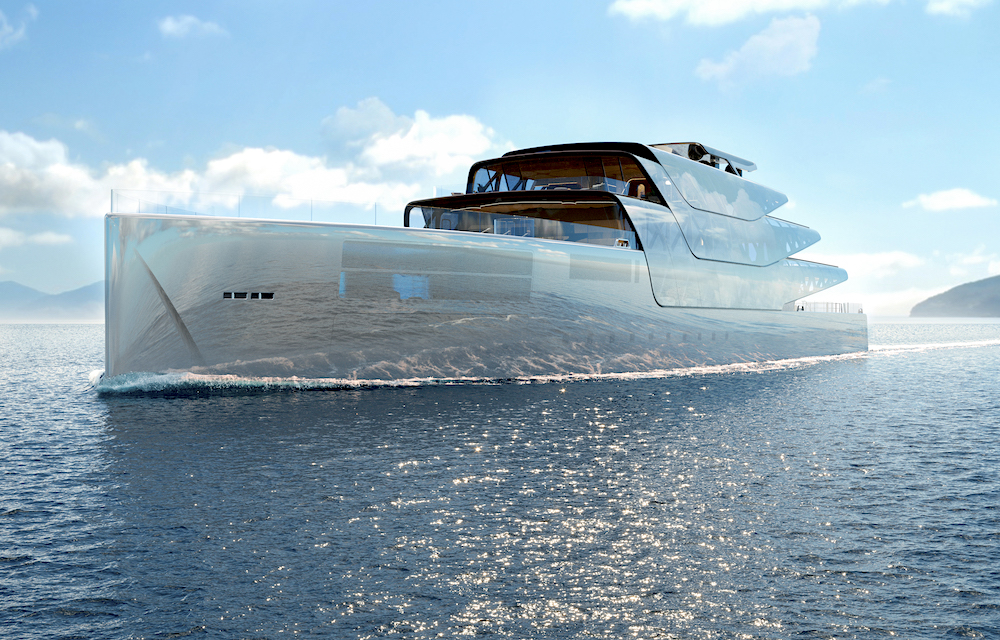
Multidisciplinary designer Jozeph Forakis has unveiled the concept for a luxury superyacht, christened Pegasus, that he described as “invisible both in design and in her environmental impact.” When completed in 2030, the futuristic 288-foot ship will become the world’s first 3D-printed sea vessel that produces zero emissions and can cruise with near-infinite range.
Pegasus is virtually invisible on the open sea. Courtesy of Jozeph Forakis.
Forakis said the inspiration for Pegasus can be traced directly to architecture firm Diller & Scofidio’s Blur Building for the 2002 Swiss Expo. That project, an open-air pavilion hovering over Lake Neuchâtelin in the Swiss town of Yverdon-les-Bains, shrouded visitors in a mass of fog produced by lake water shooting through 35,000 high-pressure nozzles. In recent years, the firm has worked on the High Line in New York and the expansion of the Museum of Modern Art, as well as Moscow’s controversial Zaryadye Park, an experiment in “wild urbanism.”
With its high-tech, “virtually invisible” design, Pegasus is envisioned to be as harmonious with nature as possible. “The dream [behind Pegasus],” said Forakis, “was to occupy one form of water, the clouds, and float above another, the sea, while providing every protection, comfort, and power for exploration.” Readers may recall the cloud installations of Dutch artist Berndnaut Smilde, who Forakis said is another of his influences.
Rendering of Pegasus’s 3D-printed mesh framework. Courtesy of Jozeph Forakis.
The yacht’s construction uses robotic 3D-printing to create a durable yet lightweight mesh framework for both the hull and superstructure, taking up far less energy, material, and time compared to conventional shipbuilding methods.
The exterior’s silver-metallic finish mirrors the sea’s colors and motions, while massive “solar wings” reflect the clouds and the sky. With its solar energy converting seawater into hydrogen, then into electricity, the wings also ensure Pegasus can cruise almost indefinitely. The clean energy can also power onboard amenities.
The ‘tree of life’ in Pegasus’s interior. Courtesy of Jozeph Forakis.
Further communing with nature, Forakis has incorporated a multi-level “tree of life” as the interior centerpiece—a living monument that doubles as the base of a hydroponic food garden surrounded by a meditative zen garden and a reflecting pool. The tree extends vertically through all four levels of Pegasus.
“I am passionate about new technologies, materials, and processes, which, to borrow from [Italian design academic] Ezio Manzini, offer new ‘materials for invention,’” explained Forakis. “I regard design as an art form. I am myself a child of the arts. Both my parents, Peter Forakis and Phyllis Yampolsky, were seminal artists of the 1960s and ‘70s. Everything I do is filtered through that lens.”
Other features onboard Pegasus include an aquarium-style lap pool, an oversized jacuzzi, and large windows that transform into open balconies. The top level remains the domain of the owner, with a forward-facing master suite featuring a large private terrace.
Pegasus’s master suite. Courtesy of Jozeph Forakis.
“The challenge I always give myself is to achieve a holistic ecosystem of ideas and expression, as balanced, essential, and poetic as ecosystems in nature,” said Forakis. “I am interested in addressing humanistic needs in harmony with the environment.”
More Trending Stories:
Superstar Painter Peter Doig Has Parted Ways With His Longtime Gallery Michael Werner After 23 Years
Here’s Your Go-To Guide to All the Fairs Taking Place Over Frieze Week in Los Angeles